
RECENT TORTIE AND CALICO MALE CATS

 |
Piotr Pacholskie, a Maine Coon breeder in Poland, has this very interesting stud cat - Waldan Pohulanka*PL – who has small black patches on his red coat. Cat show judges believe him to be a chimera, but without DNA testing this can’t be confirmed. The black patches could also be localised mutations (like moles or birthmarks). Unfortunately Felis Polonia (affiliated to FIFe) want him to be neutered although he is a very handsome and fertile stud cat who has produced many good offspring (correspondence Feb 2019). |
 |
Image courtesy of Melusine from SOS Siamois Franco Suisse which rescues Siamese-cross cats in France, Switzerland and Belgium. She has photographed the under-tail evidence of this tortie-point's claim to the male gender. |
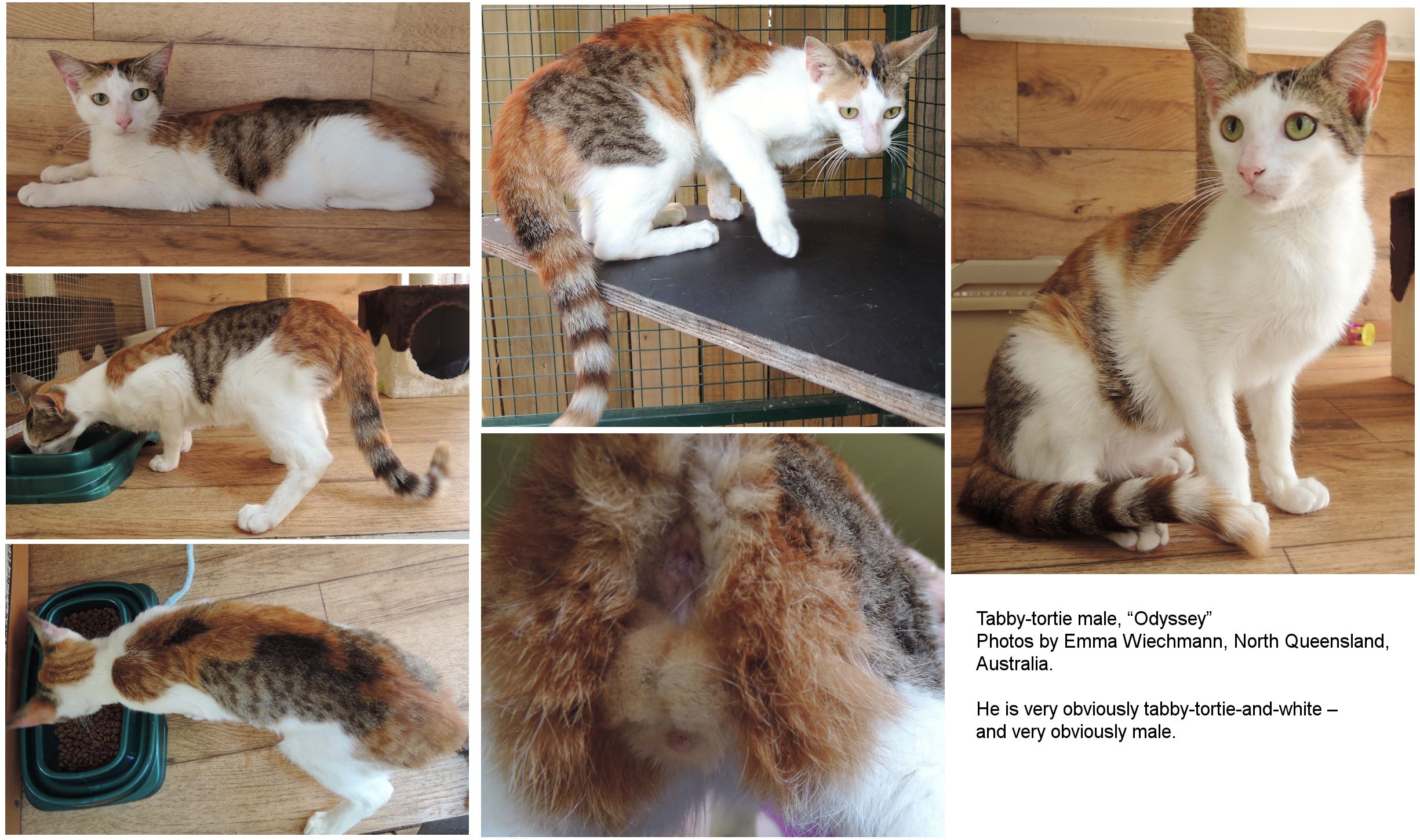
Emma Wiechmann, who runs a small cat shelter in North Queensland Australia, sent me these photos of a tabby-tortie-and-white male, “Odyssey”. The most common cause of tortie males is chimerism, and the males are fertile so it is important that they are neutered if not required for breeding.
 |
In July 2017, Janet McArthur sent these photos of a red smoke boy called “Golden Topaz” who has a black smoke patch on his body. His sire is a black smoke and white with a solid black patch on one hind leg – and has produced smoke kittens that also have solid black patches. The mother is a blue tortie and white and the two littermates are red and white boys (which rules out embryos bumping into each other and swapping a few cells). These patches look like somatic mutations – patches of skin where a cell mutated and the patch grew as the embryo developed and as the kitten grew. These are like birthmarks. Janet also has a red smoke and white girl with sold red patches in the coat and again it appears that a localised mutation, e.g. partial non-disjunction, has resulted in some cells lacking the silver inhibitor gene. These are mostly explained as "bad silver" i.e. the silver not coming to full expression in some patches. Normally, when body cells divide, each chromosome unzips into 2 strands (called chromatids) and each daughter cell gets one of the strands. In non-disjunction, both strands go into one daughter cell and no strands go into the other. In partial non-disjunction, a fragment of the chromatid - and therefore the genes on that fragment, for example the silver gene - is missing from the daughter cell. Because there are several cats with these solid patches, it’s possible that something else in their genetic code makes them susceptible to this sort of mistake when body cells divide, such as a mutated protein necessary for cell division. |
 |
In December 2013, Joy Fatooh adopted a tortoiseshell kitten from an animal shelter who, according to her friends, looked as if it had been designed by committee or assembled from random cat parts: a tuxedo tortie with orange tabby hind legs. The adoption papers and the vet said "female" but when Joy took 13 week old Monster for vaccinations, the vet admitted she hadn't taken a good look under Monster's tail before. Monster had a distinct set of male attributes under HIS tail. Monster also has large, low-set ears and wavy whiskers, similar to a Devon Rex. His mother is grey and his brother is a normal black tuxedo cat. The photos show Monster at 9 and 13 weeks, showing his odd coloration from several angles, including his male attributes! When Monster was neutered, at Leslie Lyon's direction the vet sent his testicles to her current lab and his blood sample to Lee Millon at her former lab. Dr Milici, the vet who did the neutering, told Joy that Monster "looked like a normal boy." After several weeks the lab with the blood reported that they were having some difficulties with the sample, but were finding no Y markers: "The DNA results show Monster to be a female." A month later, Dr. Millon reported "All DNA data shows female markers only and is SRY negative." SRY is the gene on the Y chromosome that's usually responsible for testicular development. Sometimes as a result of a mutation it will show up on the X chromosome. If there is no SRY gene, yet testes have developed, then it's usually due to an excess or absence of one of the several other genes involved in sexual differentiation. If this describes Monster, he's what they call "SRY-negative XX sex-reversed." The other alternative is that Monster is a chimera and that the testicles developed from a male embryo that has merged with a female embryo. Monster grew up into a healthy, lively, intelligent, playful, affectionate little cat who didn't care if you call him or her "he" or "she." He's very small: at his last trip to the vet he was 9 months old and only weighed 4 pounds 1 ounce. He still has huge ears, but his whiskers are no longer wavy. He loves to travel by car and explore new places, and to take Joy for walks on a leash. When she says "Monster, want to go for a walk?" he gallops to the door making happy sounds. "As of August 2019, we can no longer report that Monster is entirely healthy. At less than 6 years of age he’s been diagnosed with elbow dysplasia and hip dysplasia — both rare in cats — and with arthritis and kidney disease, both rare in so young a cat. His veterinarian feels that all of this is most likely attributable to whatever mutation is responsible for his sex-related anomalies; or, as she puts it, “He’s just a weird cat!” His prognosis is good, he is responding well to treatment, and he still enjoys the same activities, although he saunters slowly instead of galloping." In 2020, Terje Raudsepp, Professor & Director of the Molecular Cytogenetics Laboratory at Texas A&M University, reported Monster to be genetically clearly female with a normal 38, XX (SRY-negative) feline karyotype. This certainly explains Monster's tortoishell color but not the male parts removed during neutering. To find out why Monster grew male parts would require whole-genome sequencing, but even that might not provide an answer as environmental factors (hormones in utero, exposure to chemicals in utero) can play a part. |
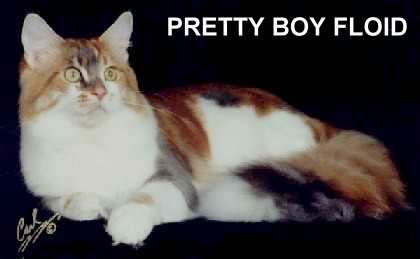 |
Are there a disproportionate number of tortie males in the Maine Coon breed? Pretty Boy Floid is a famous fertile red, grey and white Maine Coon tortie male (he is an XY/XY chimera). Perhaps all the brouhaha over Pretty Boy Floid has simply made people more likely to report these unusual males. |
 |
Fernando of Canpaza is a cream-coloured German Maine Coon (born 2002) with two small blue spots on the top of his head which may be due to a localised mutation of skin tissue. Several breeders told Fernando's breeder, Elvi Weidemann, to neuter this unusual tomcat and sell him as a pet. However, a veterinary hospital in Hanover (Germany) was running a study project on tortoiseshell tomcats and Fernando was included in that project. A blood test proved he was a normal XY male. Breeder and researchers were keen to see if Fernando could father kittens - and what colour he passes on to his kittens. In December 2003, the results of Fernando's matings were announced. He was mated with Roxanna a black-silver tortie resulting in 8 kittens weighing between 70 and 95 grams (smallish, not unusual for a large litter): 1 cream-smoke male (Bucky), 1 black-silver tortie female, 1 red tabby female, 3 red males, 1 black tortie female, 1 cream male and a black-silver tortie male. Sadly the latter 5 kittens died of a bacterial infection; the black-silver tortie male being an especial loss. Fernando had one further test mating before being neutered. It was particularly interesting that a tortie male produced a tortie son, but there are now several reports of two, or even three, generations of tortie males in a pedigree. |
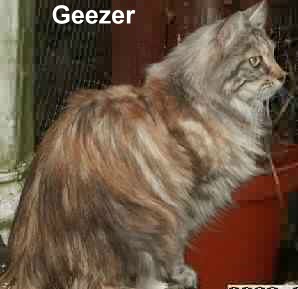 |
Another Maine Coon tortie male, Koonikki Feirfiz Geezabird (Geezer), had intersex traits - testicular tissue in the position of an ovary plus one normally descended testicle. Geezer reportedly had both male and female behaviour and the vet believed him to be XXY. Like Skipper (described in Tortie Tomcats: Chimeras), he solicited other males to mate him, but he also attempted to mate females. His father has since sired another tortie male (tortie tabby from a brown tabby female) so possible the father is producing aberrant XY sperm. |
|
|
A third tortie Maine Coon, Stormwatch Maxwell, was reported in 1997. Sired by a black smoke, Maxwell was mostly bright red, but had a black patch on one side of the face. |
|
|
Marie Hope, Coldstream Cattery, has another tortie Maine Coon, Simba, a tortie-tabby whose red is mainly along his lower back and the base of his tail. One side of his face is black/brown tabby while the other is red tabby. This is more than the rufousing that is sometimes seen on the muzzles of tabby cats. |
| Miky (Kapamba's Home Miracle) is a Dutch-bred tortie-tabby-and-white male Norwegian Forest Cat. He was probably sterile as he has now been castrated (to eliminate other male behaviour such as spraying) and there are no reports of him siring offspring prior to castration. His chromosome make-up hasn't been investigated, but the well defined patched pattern suggests either XXY (Klinefelter) or a chimera. The cattery appears to specialise in tortoiseshell-and-white Norwegian Forest Cats. |
 |
|
The cat above is a seal-tortie point Birman, Grand International Champion Dar es Salaam's Varsha. Varsha was a stud cat that sired a number of very good kittens and he breeds as though he were a red-point. The distribution of black on his coat suggests he is a chimera. It is interesting that he has achieved Grand championship status as many registries cannot accommodate tortie males in competition, except as "Any Other Colour". |
 |
It is interesting to me that so many of the recently reported tortie males belong to longhaired breeds such as Maine Coons, Siberians, Norwegian Forest Cats, Birmans and Persians. In 2015, a newly recognised colour effect called "Sunshine" was identified in Siberian cats, this turns some areas of black pigment to red pigment. When present in silver tabbies/chinchillas it gives rise to the "bimetallic" effect where both silver and golden patches are present in the coat. It cats without the silver gene, it gives the impression of tortioseshell or torbie. However, that currently only accounts for apparently tortie males in the Siberian breed.
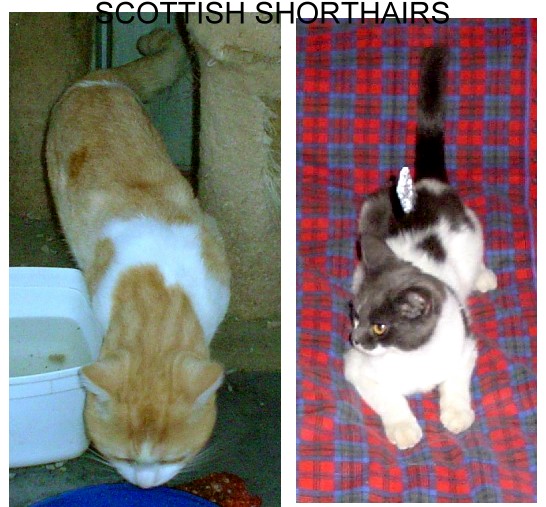 |
In 2005, breeder Peta Cohen (Kamikai Kattery, Victoria, Australia) came across two Scottish Shorthair (straight-eared Scottish Fold variants) cats with unusual coat patterns. One was a red-cream-and-white which also had two dark red patches on the coat. The other was a black-grey-and-white patchwork. These cats both had a mix of dilute and non-dilute colours, indicating chimerism. They came from a Scottish Shorthair/Fold breeder who had also bred a chocolate-lilac-cream female cat, and several more red-cream-and-white patched cats and black-grey-and-white cats. |
 |
In 2008, a male torbie-and-white Scottish Fold was reported, but there was no indication it was related to the Scottish Shorthairs reported previously. |
 |
In November 2014, Hayley Keoghan, a hobby breeder of Siamese and Orientals, wrote of a very unusual little boy born in one litter. Stilton, as Hayley named him, was approaching 14 weeks and had the best tortie markings in the house! He is a blue tortie point male (physical sex confirmed by the vet) and has 2 female littermates. Hayley has been trying, so far without success, to get him DNA tested. The photos show him still developing colour on his legs and feet, but his nose leather already shows a mix of blue and pink, he has a cream flash in the blue point on his face and his ears are mottled in appearance. His mum is a blue tortie too and Stilton has very similar makings to her. |
Very occasionally, the tortoiseshell "male" is not male at all. It is genetically a female cat which, due to hormonal problems during embryo development, has developed the external characteristics of a male cat. This is the normal condition in female hyenas where the clitoris is elongated to form a pseudo-phallus and there is also a false scrotum. It is occasionally been reported in other animals which appear to be hermaphrodite, intersex or are masculinised females (genetic females which look like males). Depending on the cause, the false scrotum may contain fatty tissue or ovarian tissue. This may explain those cases of tortoiseshell "males" which act like females - they are genetically female with an external male appearance. These gender anomalies are discussed in more detail in a later section.
A small localised patch of colour can result from a localised mutation in the tissue, in effect a birthmark.
In January 2015, Tetske de Jager wrote to me about her red calssic tabby tomcat, Garfield, who has a dark mark as well as several physical anomalies. He has deep black blotches at his feet (which have long carpal pads) and stripes/areas on his paws appear a much darker colour than the rest of his body. Unfortunately for this page, Garfield is rather timid and doesn't like having his photo taken! He is cow hooked, his hind legs are longer then should be. His tear ducts always show discharge, his nose is mildly malformed and he has canine teeth that protrude when his mouth is closed. His voice is is quiet and a little hoarse, or as Tetske says, it sounds "as if he has been screaming 3 days." Despite being 2.5 years old and not yet neutered at the time of reporting, Garfield isn't interested in finding females, not even when in close proximity to a sexually mature and (at the time) unneutered female. It is possible he is inbred or was ill as a kitten and a vet has suggested that Garfield's mother might have had FCV. Because the black blotches are so localised, it probably that this is the equivalent of a birthmark, although Garfield's physical anomalies and lack of masculine behaviour raises questions about a gender anomaly.

(2016) Polly McNichols sent some photos of two male tortie littermates, Edward (pictured as a kitten and an adult) and Rocky (who was adopted, so only shown as a kitten). Edward was 18 months old at the time of the adult photos. He's a pale orange tabby and has one grey tortie paw and lower leg. His mother was a feral black and orange tortie and his dad was a feral pale orange tabby (both parents are now neutered). His blue markings could be due to a skin cell mutation (like a birthmark). Since all the litter were orange or cream (4 males and 1 female), he can’t have swapped cells with a darker sibling in utero. His overall coat colour is interesting. He has a dusty blue hue to his fur. The first time he went to the vet the vet tech commented that it looked like someone had sprinkled dust all over him. This resembles an effect dubbed "blue ginger" where not all eumelanin is converted to phaeomelanin. Unlike most blue gingers reported, Edward’s doesn’t have bluish face, tail and paws. He just has a mottled left front paw and some bluish spots on the back of his hind paw, plus a little at the base and tips. His littermate, Rocky, had a definite bluish grey hue to the end of his tail, hind paws and legs.

In 2016, Leyna Warren collected two kittens, littermates, for rehoming. At first she thought the fluffy orange tabby was just dirty, but he turned out to have black/grey/brownish spots on him. He also has one blue eye (reflects red) and one green eye. His mother, grandmother, and most of the other female cats in the area are tortie-tabbies. His litter-brother is orange and his litter-sister is a vivid brown tabby. He has a relatively faint "split" down his nose, black splotched nose leather, spotting on his ears, and dark areas on his feet and toe pads. This suggested to me that the orange tabby and his brown sister may have exchanged a few cells early on in their development. Alternatively, it is the equivalent of a birthmark – a somatic mutation. However … Leyna knows of three more male orange tabbies with dark spots in the past 2 years (she volunteers at Cat Haven of Baton Rouge, Louisiana). All were definitely male, neutered while with the rescue, and healthy. Two were kittens and one was an adult. None were the usual tortie colouring, but instead were mostly orange with a small patch of tabby. In February 2022, at the age of 5 years, Ezra was diagnosed with terminal B-Cell Lymphosarcoma diagnosis and had to be euthanized on March 24th. After his diagnosis, Leyna contacted Dr. Leslie Lyons and also Dr. Terje Raudsepp at Texas A&M. They analysed some blood samples and some tiny tissue samples taken after Ezra was euthanized. Ezra was a blood chimera with 96% of his blood cells having XX (female) karyotype, but the DNA of his skin cells was XY (male). Although his skin cells were male, the melanocytes (derived from the neural crest) might have been XY and/or XX..


A mosaic that made online headlines in 2012 was not a male tortie, but a strikingly marked female known as "Venus the Chimera Cat". Venus has a brindled body and a face that is a perfect half-and-half of black and ginger. Intriguingly, her eye on the ginger side is blue, while that on the black side is green. This doesn't necessarily make Venus a chimera (fused embryos) cat - that would require DNA testing of the black and ginger sides to determine. The solid black area could also be a result of cell mutation (resulting in an effect like a birthmark). The colour of the fur is linked to eye colour, so a mutation in that area would affect both skin pigment and eye pigment. The blue eye on the ginger side is unusual, but not unknown and may be related to her having the white-spotting gene.
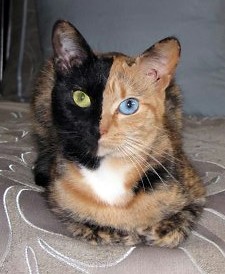
|
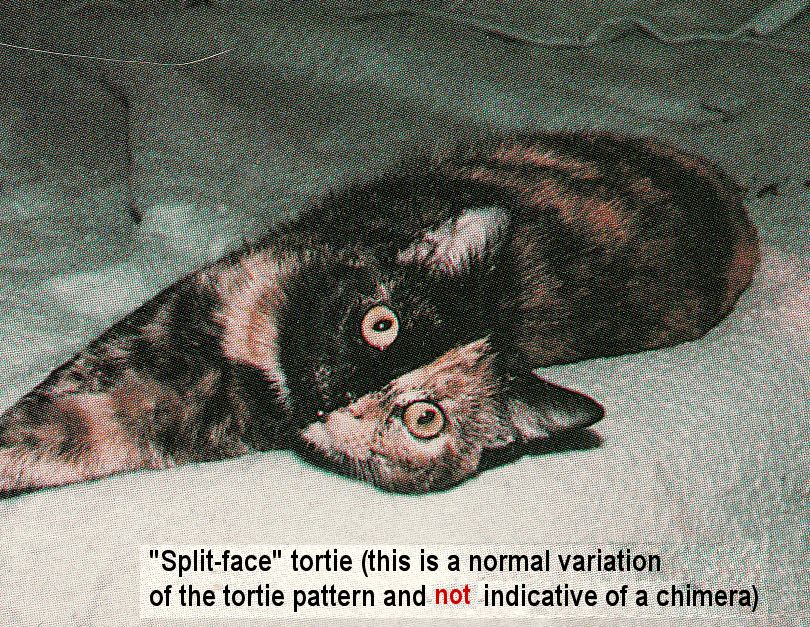
|
Next Page: Early Reports of About Tortie Tomcats